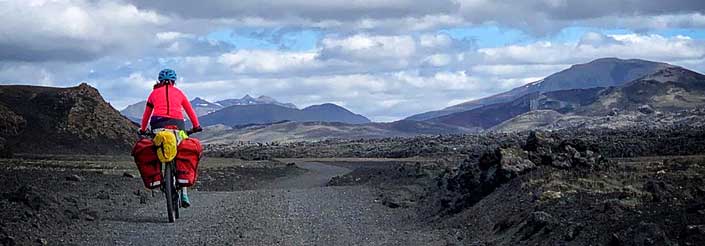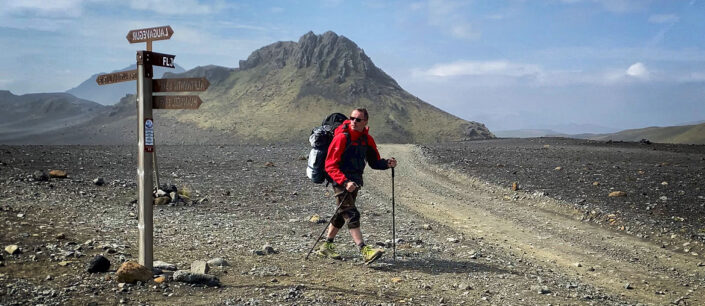Organized tours remove the need for you to plan the trip and drive the car yourself, and provide you with a guide. As a rule, however, they will be quite a bit more expensive than renting a car and going around the island on your own.
Is it possible to visit Iceland without renting a car? Certainly, but you just need to understand a few things.
If you want to avoid renting and driving a car yourself, you can naturally join road trips organized by both local and Polish travel agencies.
Bus tours in Iceland
If you only have a few days to spare, bus tours from Reykjavik may be a reasonable option. These are usually 1-day tours, so they don’t go too far from Iceland’s capital. Their basic and most popular route is the so-called Golden Circle and the southern coast and Snaefellsnes Peninsula. You can find a wide selection of interesting day tours here: 1-day Classic Tours. If you want to spend no more than a week on a trip to Iceland and do not want to rent a car, then the best solution would be to find a good “base” in Reykjavik itself and take some of the most important or interesting round trips.These most important, or basic, tours that should be taken are:
- A tour of the so-called Golden Circle, such as this one: Golden Circle Classic or a version with a visit to perhaps the most interesting (besides Blue Lagoon) spa center: Golden Circle & Hvammsvik Lagoon;
- Tour of the southern coast. Here, in fact, the 2- or 3-day tours are the best, as they are less strenuous and reach as far as the Jokulsarlon lagoon and Diamond Beach; this tour, for example, is this one: 2-Day South Coast Tour w/HOTEL; however, if you want or need to limit yourself to 1-day tours, you will probably reach “only” Vik and Reynisfjara Beach there; these are still beautiful tours, just half as long, e.g.: South Coast Classic or South Coast Wonders;
- An excursion to the Snaefellsnes Peninsula, sometimes called “Iceland in a nutshell,” e.g.: Snæfellsnes Peninsula Tour;
- Excursion north of Reykjavik – to the so-called Silver Circle, e.g..: Silver Circle Small Group Day Tour;
- In the summer, a whale (and maskonur) watching cruise is also definitely worthwhile; we write about it comprehensively in this article: Whale Watching in Iceland – All You Need to Know [Complete Guide]; and one of the most interesting such tours from Reykjavík is Reykjavík Whales & Puffins;
Of course, several-hour walking tours of Reykjavík itself and its attractions are also available (if you want to explore Reykjavík on your own, see this article: Sightseeing Reykjavik – Top Things to See and Do). Naturally, multi-day tours are also available. The shorter ones – 2 or 3 days – usually focus on most of the southern coast and/or parts of the interior. The 6-day and longer tours already allow you to see and go all around Iceland.
Organized tours remove the need for you to plan the trip and drive the car yourself, and provide you with a guide. As a rule, however, they will be quite a bit more expensive than renting a car and going around the island on your own.
Going to Iceland in your own car
Is it possible to visit Iceland and get around by your own car? Yes, although it is only worthwhile for longer trips. Iceland cannot be reached by any land route, so if you want to drive around Iceland in your own car, you will have to cross here aboard a ferry. Currently, the only ferry connection to Iceland is maintained by the Smyril Line running between the Danish port of Hirtshals (about 900 km northeast of Szczecin) and Iceland’s Seyðisfjörður, located in the east of the island.
Unfortunately, both the sheer cost of the ferry trip (at least about €500 per person + another €500 for a car) and the duration of such a crossing (including getting to/from Hirtshals is a minimum of three days each way) make it an attractive choice only if you can allocate at least three, and preferably four or more weeks for the entire trip. The schedule changes slightly every year, but in 2025, for example, ferries run once a week from mid-March, through mid-November, and twice a week from early June through the first week of September. Along the way (each way), the ferries make a brief stop at the port of Tórshavn in the Faroe Islands. The ferry only stands in port for a few hours, but you can buy a ticket that entitles you to disembark and continue your journey on the next ferry (in 3-4 days, a week or even later).
Touring Iceland by bicycle
 Cyclists (but also motorcyclists) love and highly praise trips around Iceland. Probably, rather strong fascinators of this form of travel and leisure decide to do it, so people a little less sensitive to various problems and challenges, but it is difficult to meet a cyclist dissatisfied with his trip to Iceland. Among the advantages of exploring Iceland on a bicycle saddle, in addition to the beautiful views, is certainly the freedom of travel, because traveling by bicycle, we can pitch a tent for the night practically anywhere, except on private property and in places where it is directly prohibited.
Cyclists (but also motorcyclists) love and highly praise trips around Iceland. Probably, rather strong fascinators of this form of travel and leisure decide to do it, so people a little less sensitive to various problems and challenges, but it is difficult to meet a cyclist dissatisfied with his trip to Iceland. Among the advantages of exploring Iceland on a bicycle saddle, in addition to the beautiful views, is certainly the freedom of travel, because traveling by bicycle, we can pitch a tent for the night practically anywhere, except on private property and in places where it is directly prohibited.
On the challenge side, the list is unfortunately much longer. First of all, Icelandic roads are really narrow and devoid of shoulders. While cars are not allowed to exceed 90 km/h, and drivers, as a rule, drive calmly and carefully, it’s certainly not a comfortable ride. Many bridges in Iceland are single-lane bridges. A bicycle won’t fit on them next to a car, so you have to negotiate the crossing with vehicles going in both directions However, the biggest problem for cyclists is the wind. The wind in Iceland blows practically always and very often it is really strong. Because of this, cycling is practically always against the wind, and you always have to be vigilant so that a side gust doesn’t knock you over.
InReykjavik, which is definitely not the windiest place in Iceland, maximum wind gusts reach as high as 36 m/s (130 km/h), and for example, in the whole year 2022, on average, these maximum wind gusts were 12.5 m/s (45 km/h) (average of the maxima on each day of the year; the latest data we have).
It’s because of the wind that all car rental companies warn drivers to be careful when opening their doors, as the wind can rip them out of their hands and then off their hinges. Cyclists have to be doubly careful.
Sightseeing Iceland on foot
Iceland as much as possible can also be explored completely without any (own) means of transport. There are many walking trails on the island. The most popular of these is certainly Laugavegur and the adjacent Fimmvorduhals and Hellismannaleid. These three trails are certainly the most popular, but also the best to visit. Their start and end can be reached by bus directly from Reykjavik, campgrounds and shelters with basic supplies can be found along the route, and help can reach you relatively easily in case of trouble. However, less popular routes are plentiful in Iceland. And although they are concentrated around such places and regions as Kerlingarfjoll, Askja or the Westfjords. in fact their network covers basically all of Iceland. However, it’s important to remember that – especially in the interiors – these tend to be really wild trails, where the path is rarely clear, stores along the way are lacking, and we may have GSM coverage once every few days. If you like such adventures, Iceland is perhaps the last place of its kind in Europe… If you want to go trekking in Iceland, be sure to start by reading this article: How to prepare for a hiking trip in Iceland.
However, less popular routes are plentiful in Iceland. And although they are concentrated around such places and regions as Kerlingarfjoll, Askja or the Westfjords. in fact their network covers basically all of Iceland. However, it’s important to remember that – especially in the interiors – these tend to be really wild trails, where the path is rarely clear, stores along the way are lacking, and we may have GSM coverage once every few days. If you like such adventures, Iceland is perhaps the last place of its kind in Europe… If you want to go trekking in Iceland, be sure to start by reading this article: How to prepare for a hiking trip in Iceland.
Hitchhiking tour of Iceland
FINALLY, as much as possible you can also explore Iceland without renting a car, but using local bus lines and hitchhiking
There are buses of the state-owned Straeto lines running all around the island (see map and schedule of the lines outside Reykjavik). From a tourist’s perspective, these buses are not perfect. They run quite infrequently, and have stops in every major town rather than at tourist attractions. For example, to Reynisfjara beach on foot from the nearest bus stop we will walk at least 1.5h through the mountains. To Geysir park from the nearest bus stop is more than 20 km, and to the Gullfoss waterfall even 30 km. Therefore, in practice, bus rides need to be quite supplemented by hitchhiking. Hitchhikers are rather few in Iceland, so the occasional ride (both on the main roads and in the interiors) is quite easy to “catch”. However, it definitely slows down and limits our trip, so we then need much more time to complete any route than if we were moving around in our own car, or even by bicycle.A tour based on local buses and hitchhiking will probably be most attractive in areas where various interesting places to see are abundant and lie quite close to each other, quite densely on the map. Thus, this is the so-called Golden Circle, South Coast and the Snaefellsnes Peninsula.
Top tips for Iceland without a car
If you want to go to Iceland and avoid renting a car, you will definitely find these guides useful:

